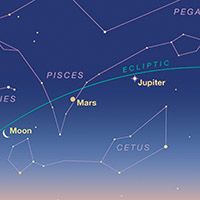Rare opportunity to see 5 planets in the sky at once with the naked eye
posted Friday, June 24, 2022 at 9:00 AM EST

For the next several weeks, stargazers can view five planets in the sky at once. In the predawn sky, about 60 to 90 minutes before sunrise, viewers can see Mercury, Venus, Mars, Jupiter and Saturn in the sky, with the moon joining the party as well.
As a bonus, the planets will appear from left to right, looking east, in ascending order from closest to furthest away from the Sun. It's quite the rare event, having last occurred in the morning sky in December 2004. For viewers in the US, the last spread of planets was visible in July 1957. It's not quite a once-in-lifetime event, but it won't occur again until March 2041.
Per Sky & Telescope, one of the best viewing days will be June 26, when a thin Moon and Venus will "meet in conjunction."
Fortunately, you don't need any special equipment to view the display; you can capture it with a wide-angle lens. All five planets are visible with the naked eye, and you don't even need an especially dark sky to see them. You can even view them from a city, per Allyson Bieryla, manager of the Science Center Astronomy Lab and Telescope at Harvard University. She told the Boston Globe, "These objects are much brighter than stars, so it should be fairly obvious even to a novice observer." Bieryla continued, "You should be able to spot Saturn, Jupiter, Mars, and even Venus for several more weeks in a similar lineup. Mercury is only visible for brief periods of time and only fairly low in the horizon because of its orbit, but if you miss all five planets, I encourage you to look up in the early morning anytime over the next several weeks to see how many planets you can spot. The moon will only appear in this lineup for the next few days, and then not again until next month."
A parade of planets is underway, and for the next two days, the crescent Moon will join the crowd.
— NASA (@NASA) June 23, 2022
Where are you watching from? Share your planetary alignment photos with us—bonus points if the weather is good: https://t.co/9iX86VJF7K pic.twitter.com/eNFK1SOdBU
If you'd like a closer look, a small telescope or binoculars on a tripod will allow you to see Jupiter's four largest moons, the Galilean moons, and Saturn's rings. Bieryla adds, "If you are in a dark enough location with a small telescope, you might also be able to see the atmospheric bands in Jupiter's atmosphere!" If you need help finding dark sites near you, click here.
For more information, check out NASA's skywatching guide for June.
(Via Boston Globe)